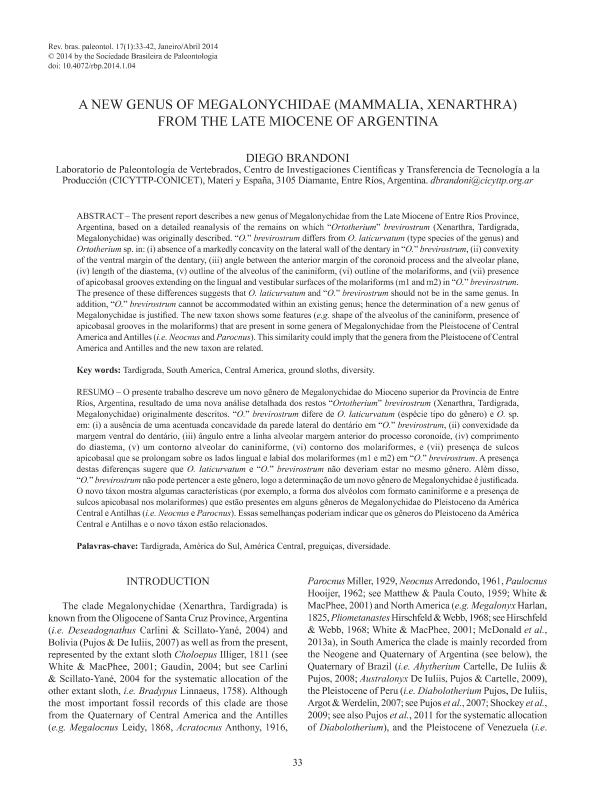Artículo
The present report describes a new genus of Megalonychidae from the Late Miocene of Entre Ríos Province, Argentina, based on a detailed reanalysis of the remains on which "Ortotherium" brevirostrum (Xenarthra, Tardigrada, Megalonychidae) was originally described. "O." brevirostrum differs from O. laticurvatum (type species of the genus) and Ortotherium sp. in: (i) absence of a markedly concavity on the lateral wall of the dentary in "O." brevirostrum, (ii) convexity of the ventral margin of the dentary, (iii) angle between the anterior margin of the coronoid process and the alveolar plane, (iv) length of the diastema, (v) outline of the alveolus of the caniniform, (vi) outline of the molariforms, and (vii) presence of apicobasal grooves extending on the lingual and vestibular surfaces of the molariforms (m1 and m2) in "O." brevirostrum. The presence of these differences suggests that O. laticurvatum and "O." brevirostrum should not be in the same genus. In addition, "O." brevirostrum cannot be accommodated within an existing genus; hence the determination of a new genus of Megalonychidae is justifi ed. The new taxon shows some features (e.g. shape of the alveolus of the caniniform, presence of apicobasal grooves in the molariforms) that are present in some genera of Megalonychidae from the Pleistocene of Central America and Antilles (i.e. Neocnus and Parocnus). This similarity could imply that the genera from the Pleistocene of Central America and Antilles and the new taxon are related. O presente trabalho descreve um novo gênero de Megalonychidae do Mioceno superior da Província de Entre Ríos, Argentina, resultado de uma nova análise detalhada dos restos “Ortotherium” brevirostrum (Xenarthra, Tardigrada, Megalonychidae) originalmente descritos. “O.” brevirostrum difere de O. laticurvatum (espécie tipo do gênero) e O. sp. em: (i) a ausência de uma acentuada concavidade da parede lateral do dentário em “O.” brevirostrum, (ii) convexidade da margem ventral do dentário, (iii) ângulo entre a linha alveolar margem anterior do processo coronoide, (iv) comprimento do diastema, (v) um contorno alveolar do caniniforme, (vi) contorno dos molariformes, e (vii) presença de sulcos apicobasal que se prolongam sobre os lados lingual e labial dos molariformes (m1 e m2) em “O.” brevirostrum. A presença destas diferenças sugere que O. laticurvatum e “O.” brevirostrum não deveriam estar no mesmo gênero. Além disso, “O.” brevirostrum não pode pertencer a este gênero, logo a determinação de um novo gênero de Megalonychidae é justifi cada. O novo táxon mostra algumas características (por exemplo, a forma dos alvéolos com formato caniniforme e a presença de sulcos apicobasal nos molariformes) que estão presentes em alguns gêneros de Megalonychidae do Pleistoceno da América Central e Antilhas (i.e. Neocnus e Parocnus). Essas semelhanças poderiam indicar que os gêneros do Pleistoceno da América Central e Antilhas e o novo táxon estão relacionados.
A new genus of Megalonychidae (Xenarthra, Tardigrada) from the Late Miocene of Argentina
Fecha de publicación:
01/2014
Editorial:
Sociedade Brasileira de Paleontologia
Revista:
Revista Brasileira de Paleontologia
ISSN:
1519-7530
Idioma:
Inglés
Tipo de recurso:
Artículo publicado
Clasificación temática:
Resumen
Palabras clave:
Tardigrada
,
South America
,
Central America
,
Ground Sloths
,
Diversity
Archivos asociados
Licencia
Identificadores
Colecciones
Articulos(CICYTTP)
Articulos de CENTRO DE INV.CIENT.Y TRANSFERENCIA TEC A LA PROD
Articulos de CENTRO DE INV.CIENT.Y TRANSFERENCIA TEC A LA PROD
Citación
Brandoni, Diego; A new genus of Megalonychidae (Xenarthra, Tardigrada) from the Late Miocene of Argentina; Sociedade Brasileira de Paleontologia; Revista Brasileira de Paleontologia; 17; 1; 1-2014; 33-42
Compartir
Altmétricas




